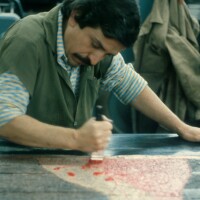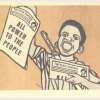El Nopal Press: 30 Years of Expanding Borders with Female Artists

For the last 30 years, El Nopal Press has intentionally been a studio where artists can experiment with printmaking. Men and women alike have been drawn to El Nopal for a chance to work with Francesco Siqueiros, a man whose reputation as collaborative, experimental printmaker precedes him. Interestingly though, some of the most provocative artistic pieces and innovations have come from the studio’s collaborations with women. The studio's experimental philosophy has fostered a sense of freedom that has become a place where women, in particular, feel that they can realize their artistic visions.
"It is a unique experience working with him because Francesco, an artist himself, shares his artistic sensibility combined with his expertise as a printmaker to his approach in working with other artists. His approach and interactions with the artists cultivate a mutual respect and an atmosphere of creativity that is conducive to exchange, experimentation and innovation — encouraging the artists to produce their best work," says artist Yreina D. Cervántez known for her politically-charged works.
El Nopal Press opened its doors in Los Angeles, California in 1990. As an American-born artist who spent his younger years in Baja, Mexico, Siqueiros wanted to internationalize the Chicano aesthetic by investigating borders, but not just the physical ones. His work and the work that comes out of his studio deal with metaphorical and psychological borders, but perhaps most of all, El Nopal is known for pushing technical borders in monotype, lithograph and relief printing.
Over the years, artists like Ruby Osorio, Dominique Liquois, Laurie Lipton, Carolyn Castaño, Shirley Jaffe and Mara Lonner have been invited or have sought out Siqueiros for his reputation for being both unconventional, highly respected and easy to work with. Far from the traditional image of the solitary artist, printmaking is a collaboration between three individuals: the artist, the master printer and the press, which takes on a life of its own. Artists know that who you work with greatly impacts the final creation.
Working with a master printer generally means agreeing to their guidance and expertise with the machines — they are after all the ones trained in how to work them. Generally speaking, printing presses usually work within certain process constraints, or they tend to have a certain "look." In the same way, we can immediately identify artists like Picasso or Frida by their style, a master printer or printing press will generally also have a style that is present in the final product. More often than not, you'll be able to see their philosophy come through. Siqueiros' collaborations have little to no trace of him, or to see it another way, what ties his work together is that it's completely unique.
"I can always tell something printed by El Nopal Press precisely because it looks like nothing I've ever seen. There is no consistent 'formula,' which is why artists love working with Francesco. We get to be exactly who we are, but with help." - Artist, Lisa Adams.
Something that contributes to the look and innovativeness of the work that comes out of El Nopal is the artists’ backgrounds in other mediums like watercolor, graphite, oils, collage, sculpture and photography. Many come to Siqueiros to challenge themselves or to try something outside of their comfort zones. Printmaking becomes a game of chess where the artist and master printer need to anticipate how the machine will move, apply or saturate the ink. They do this by tweaking their approach, swapping materials or changing how and where ink is applied. Carolyn Castaño is known primarily as a visual artist who works mostly with video, drawing, multimedia and painting. She produced 37 different lithograph/monoprints of her work “Drug Lord and Patron” and “Nation and Futbol” where she swaps different elements. She has the freedom to build on colors, patterns, shapes and images or completely change her original piece and go in a different direction entirely. In a way, all of her experiments have the potential to be stand-alone images or parts of a larger series. The speed of reproduction makes experimenting significantly less risky and less expensive, and it shows. The combinations are endless. Many artists have tried to imitate the look of brush strokes and pencil strokes with the press while others stick to poster-style monoprint. There are also artists who want to be completely original in both process and material. That often includes finding different ways to use Siqueiros' inventions, like a converted letterpress or an off-set proofing press. Artists have also opted to replace the printing plates with different materials like fabric or wood. Even when using similar process-based styles, the results are completely different. For many artists, printmaking is less about the result and more about the technique and dialogue that leads to it.
Click left and right to see Carolyn Castaño's prints:








“Printmaking is a very special process for an artist who usually works in a solitary way. With the printer’s expertise, techniques and methods using a press are outside the usual studio practice. While that collaboration is fraught with time and material constraints, the very parameters inspire and challenge both the artist and printmaker to expand the medium to accommodate the artist's unique vision.” - Artist, Emily Cheng
Artist and teacher, Anita Bunn has co-curated three exhibits, "B.A.T. State I-III," that have featured women who have collaborated with El Nopal Press. The most recent exhibit was "B.A.T. State III" at the Carolyn Campagna Kleefeld Contemporary Art Museum (Kleefeld Contemporary), Cal State Long Beach. Although it's difficult to find a specific look or theme that brings all the artist's work together, there have been some major conceptual and thematic connections over three decades.
In 1990, Siqueiros’ first exhibit "Aquí y Allá" (From Here and From There) worked as a dialogue between Mexican and Mexican-American artists. It explored historic U.S.-Mexico cultural narratives, ideology and diaspora within Neomexicanismo. It included some of the most prominent female artists from the first wave of the 1960s and ‘70s Chicanismo, like Patssi Valdez, Yreina D. Cervántez and Margaret Garcia. As a result, the themes were personal and political documentations of their own ideological struggles with race, class, gender, cultural identity, what was happening in their communities as well as what it was like to straddle two worlds. Yreina D. Cervántez’s lithograph “The Nepantla Triptych: Nepantla, Mi Nepantla, Beyond Nepantla” (1995-1996) explores the idea of crossroads, language, and the in-between-ness of Chicanx identity. Writing in the catalog for the Museum of Contemporary Art, San Diego’s “La Frontera/The Border: Art About the Mexico/United States Border Experience,” feminist writer and activist Gloria Anzaldúa theorized that Nepantla — which translated from Náhuatl, means “in the middle” — is a fluid space for transformation. The border comes to represent a place where new identities can be constructed and where new worlds can be created.

In the early 2000s, Siqueiros and his artists began experimenting more thematically; there is more imaginative space in terms of outcome. There is a move toward concrete abstraction like in Linda Stark’s “Black Widow Society,” which is a combination of both her love for pop culture symbolism and Siqueiros' fondness for concrete abstraction. In her artist statement, Stark reveals that the black widow becomes a feminist symbol; she is the "femme fatale" that disappears in the darkness. The ubiquitous hourglass symbol also looks like a red dress resembling a woman's figure but also signifies the presence of black widow spiders all over the Southwest.






In artist Anita Bunn's 2015 lithograph “Untitled Iteration,” she creates subtle shifts in perception through repetition of images that are all slightly similar but not quite. In her statement, Bunn reveals that she created nine unique state prints with graphite ink to explore the unfamiliarity with the familiar as well as how objects negotiate a shared space. In general, there is more material experimentation, especially with ink control and application. This was also a time period in which artists began experimenting with using three even four, different processes on the same piece.

Even when artists are not specifically addressing the same facets of feminism or employing overtly feminist principles in their work, the concept of borders and the pushing of technical boundaries are part of a proud tradition of female printmakers that began with June Wayne who revitalized Southern California lithography in the '60s with her studio Tamardind Lithography. In many ways, the innovative spirit of El Nopal aligns with Gloria Anzaldúa’s theory of what is possible when artists embrace working in the “in-between.” The result has been innovative collaborations, technical and material advancements, as well as a roster of artists who defy categorization.
Author’s note:
A special thank you to Amanda Fruta, Anita Bunn and Francesco Siqueiros. Like printmaking, this article was also a collaborative project.
Top Image: Francesco Siqueiros at work at El Nopal Press | Julian Campos. Courtesy of El Nopal Press





